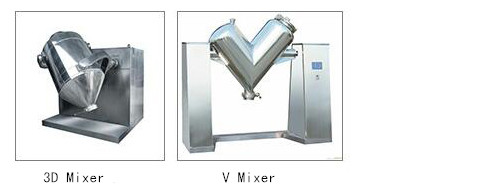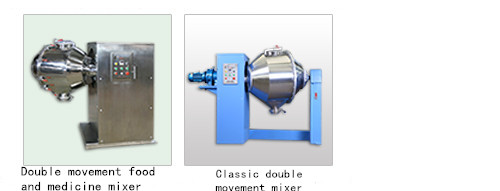First, the uniformity of powder mixing
The absolute uniformity of powder mixing is just an ideal. Every time the actual work mixed, the average meaning is relative, to process requirements is "uniform."
1. The ideal uniformity of powder mixing standards
This is just an assumption: if the particle size in a single powder is uniform and the distance from the surrounding particles is uniform, and each of the powders involved in the mixing has such an absolutely uniform distribution, Powder spatially staggered staggered distribution, so as to achieve the so-called ideal uniform distribution.
However, the actual situation is that the ideal uniform distribution does not exist because the particle sizes can not be uniform and the mutual distances can not be uniform. In practice, our uniform standards are relatively uniform standards to meet product requirements.
2. The actual work of the powder mixed uniform standards
1) Powder mixed test standards
The test of mixing uniformity is a practical standard to meet the needs of the product.
The so-called uniform in actual work is a relatively uniform standard.
Some industries require very high, such as the powder metallurgy industry usually require the alloy elements can be evenly distributed in the form of particles, in the formation of tiny metal crystals uniform alloy structure to achieve the best metal performance. Therefore, it requires uniform distribution of various powders in the microscopic crystal.
Some industries require general, such as bagged instant noodles seasoning, the powder content in the bag to meet the requirements of the formula is considered uniform. It does not matter whether the powder is evenly distributed within the package.
2) How to achieve practical standards
The standard for mixing in practice should be uniform, microscopic uniformity on both levels.
① uniform macroscopical: This is the first level of uniformity, macroscopically demanding upper and lower containers, left and right of the sampling test, the result must be the same proportion of various powders, and containers can not appear dead ends, That is, macroscopically uniform
②. Microscopic uniformity: This is the second level of uniformity, taken from the microscopic sample (only take a few hundred powder particles) observed, the particles are uniformly dispersed between the various types of powder, which is microscopic Evenly.
Only one level of uniformity is not truly uniform, only at the same time reach the two levels of uniformity to achieve practical standards.
3. Powder mixing uniformity sampling and testing
1) Sampling: Sampling and analysis, it is required that the content of the powder in the sample is consistent with the content required by the formulation. The analysis sample can know whether the mixed powder meets the requirement of uniformity.
2) the sampling method and the relationship between uniformity:
① sample location of the sample (up and down, left and right) can determine the macro-evenness of the powder;
② sample sample can be micro-micronization at the judgment of the uniformity of the powder.
3) test: there are many ways to test, food, medicine, powder metallurgy each industry has its own common test methods. For example: Microscope observation; Chemical reagent test; Electron microscopy and so on.
Second, the selection of mixed equipment
Select the appropriate mixing equipment to determine the size of the mixed batch, mixing time, etc., in accordance with the mixing process on the machine mixed.
1. Requirements for the hybrid equipment
For the powder situation, requires equipment with: good mixing uniformity, no dead ends, high mixing efficiency, low power consumption and other performance.
Requires mixing equipment can not destroy the physical indicators of powder, such as the proportion of powder, the average particle size and particle surface shape.
Also requires hybrid equipment safe operation, easy operation, power saving, labor-saving.
2. Market common existing hybrid equipment and its advantages and disadvantages
1), gravity dispersion mixer representative models
Three-dimensional mixer, V-type mixer

Advantages: mixed without dead ends; macroscopically all parts of the container powder uniform.
Disadvantages: the powder particles on the microscopic mixing uniformity is not enough; the mixing effect is low.
2), forced shear mixing mixer representative models
Single cone mixer and ribbon mixer

Advantages: high mixing efficiency; microscopic powder particles are relatively uniform.
Disadvantages: mixed with dead ends; equipment, high energy consumption.
3), gravity dispersion and forced mixing compound mixer representative models
Double movement mixer

Advantages: high mixing uniformity, can achieve uniform macroscopical and microscopic uniform; high mixing efficiency; high material loading rate; low energy consumption.
Disadvantages: equipment is relatively complex, the procurement cost is relatively high.
3. Mixing equipment selection principle
1) Choose according to the ease of mixing tasks:
Easy to mix the task of choice V-type machines and other common models; the other hand, the choice of high-performance mixer.
2) for the poor mobility of the powder can be forced shear mixing type mixer.
3) For the ultra-light powder, ultrafine powder and other difficult to mix the choice of gravity diffusion mixing system to enhance the mixing mixer.
Third, the implementation of mixed technology
1. Feeding
The usual method is to open the mixing machine feeding port with manual feeding or feeding machine mechanical feeding, closing the feeding port after finishing the feeding.
2. Equipment mixed operation
Turn on the device power, set the mixing time, start the equipment operation and mix. Pay attention to the personal safety of the operator when the equipment is running.
3 .discharge of powders
Open mixer outlet to discharge material from mixer
①. For the poor liquidity powder discharge phenomenon can be added warehouse wall vibrator to promote the smooth discharge of powder.
②. For the liquidity is good powder discharge strictly avoid powder free fall and light weight produced by the phenomenon of segregation of secondary uneven. For example, slide device can be used to avoid falling powder free fall.